Titanic Survivors, Lifeboats, and Public Response: A Visual Chronicle from Collier’s Magazine
📌 Explore rare Titanic images from Collier’s Magazine, including lifeboat evacuations, Carpathia rescues, the U.S. Senate hearings, and a charity baseball game for survivors. A must-read for historians, students, and Titanic enthusiasts.
RMS Titanic Images – Collier's Magazine 📰🚢
Introduction: A Powerful Visual Chronicle of the Titanic Disaster
Collier’s Magazine, one of the most widely read periodicals of its time, provides a vivid, photographic account of the Titanic disaster and its aftermath. This collection offers a compelling look at the rescue efforts, survivor experiences, and public response. The photographic evidence presented in this article makes it an invaluable resource for teachers, students, genealogists, and historians studying the Titanic, early 20th-century ocean travel, and maritime safety.
This article captures several critical aspects of the Titanic’s sinking, including the lifeboat evacuations, the arrival of survivors in New York, and the immediate public and governmental reactions to the disaster.
This periodical has a wide circulation, based on informative value and timeliness. A large number of its readers are men, and a corresponding breadth of viewpoint is desirable.
Uses articles of news-interest on public men and world-events, preferably illustrated. For short fiction the editorial department reports that Collier’s is going to make a specialty of short-stories and articles of from 2000 to 5000 words in length.
Collier’s first idea is to overcome the “run-over”—that is, the continuation of stories and articles from the fore part of the magazine to advertising pages farther back, and the second idea is to get a large number of features into each issue. The use of shorter stories and articles will make necessary live stories and vivid sketches of life, running from 760 to 1500 words.
Images pertaining to the Titanic disaster or its aftermath, published in Collier's: The National Weekly Magazine, published by P. F Collier & Son, Inc. in New York.
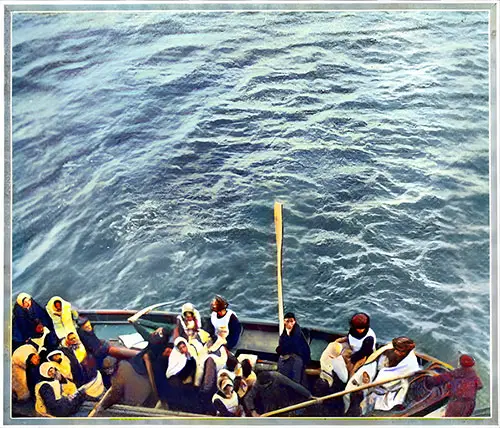
A Lightly Loaded Titanic Lifeboat Approaches the Carpathia. This Photograph Illustrates the Insufficient Loading of One Lifeboat, Which Could Have Accommodated Double the Number of Passengers. All but the Rowers Are Women and Children. Collier's Magazine, 4 May 1912. GGA Image ID # 109835ab35
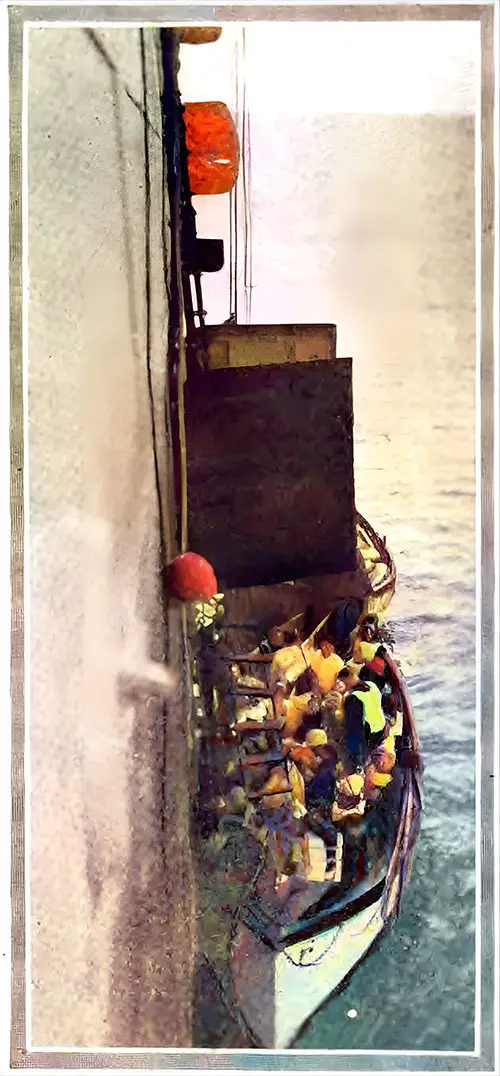
Unloading Survivors from a Lifeboat at the Side of the Carpathia, Collier's Magazine, 4 May 1912. GGA Image ID # 1098511494
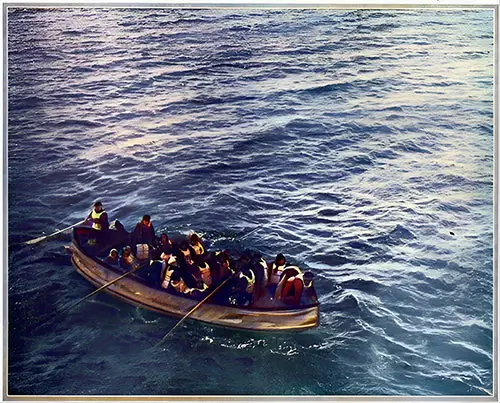
Photograph of the Collapsible Lifeboat With Survivors From the Titanic. a Passenger on the Carpathia Took This Image as the Steamship Was Retrieving the Titanic’s Lifeboats on the Morning of Monday, April 15. This Photograph Shows One of the Collapsible Lifeboats, and Its Passengers Are Primarily Men. This Particular Lifeboat Was One of the Last to Leave, but It Is Not the Damaged One to Which Many People Swam After Jumping in the Final Moments Before the Titanic Sank. Other Lifeboats Had Already Rescued the Men From This Boat When the Carpathia Arrived. Collier's Magazine, 4 May 1912. GGA Image ID # 109835ab35.
![]()
Survivors of the Titanic Relax on the Deck of the Carpathia. During the Four Days They Spent on Board the Carpathia Before Reaching Land, the Survivors and Their Waiting Friends Were Treated With Great Care and Consideration. the Image Depicts a Group of Survivors Who Were Provided With Wraps by the Female Passengers of the Carpathia. These Women Were the First in the Safety of the Outside World to Hear the Tragic Details of the Disaster. Collier's Magazine, 4 May 1912. GGA Image ID # 1098534c0e
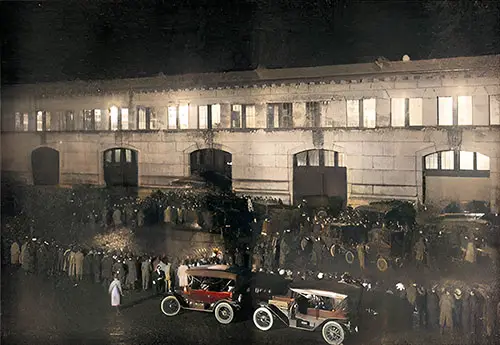
The Carpathia Arrived in New York Harbor on Thursday Night, April 18, Carrying the 705 Passengers Rescued From the Titanic. the Atmosphere at the Dock Was a Mix of Overwhelming Joy and Deep Sorrow. Police Kept Onlookers at a Distance, but the Crowd Eager to Welcome the Survivors Was Challenging to Manage. Collier's Magazine, 4 May 1912. GGA Image ID # 1031c857fa.
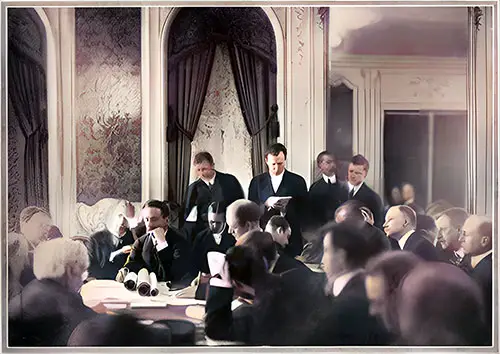
Mr. Ismay Testifying at U.s. Senate Hearings: J. Bruce Ismay, Managing Director of the White Star Line, Is Being Questioned by the Senate’s Investigating Committee. Senators William Alden Smith and Francis G. Newlands, Members of the Committee, Arrived in New York the Night the Carpathia Docked. Mr. Ismay Was Called to Testify the Following Day, and Later Sessions Were Held in Washington, D.C. Photo by American Press Association, 1912. Collier's Magazine, 4 May 1912. GGA Image ID # 1099093db2
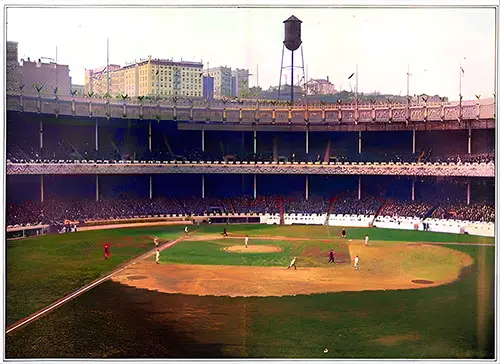
A Fundraiser for Titanic Victims - April 21, 1912. On Sunday, April 21, 1912, the New York Giants and the New York Yankees Played Baseball at the Polo Grounds to Raise Funds for the Victims of the Titanic Disaster. the Game, Featuring New York City’s National and American League Teams, Concluded With the Giants Emerging as the Winners. the Charity Event Successfully Raised $9,425 for the Cause. This Photograph Highlights the Impressive Brush Stadium, Known as the World’s Most Solidly Built, Ornate, and Largest Baseball Amphitheater. Collier's Magazine, 11 May 1912. GGA Image ID # 22428e11be
Key Highlights and Engaging Content
1️⃣ Lifeboats and the Tragic Underutilization of Rescue Capacity 🛶🚢
One of the most haunting images in this collection is the photograph of a lightly loaded Titanic lifeboat approaching the Carpathia. The image is a stark reminder of the failure to fully utilize the ship’s limited lifeboat capacity.
🔹 Noteworthy Image: Lightly Loaded Titanic Lifeboat Nears the Carpathia
📌 Significance: This image visually reinforces the tragic reality that many lifeboats left the Titanic half-full, even as hundreds of passengers remained stranded on board.
🔹 Key Passage: “This photograph illustrates the insufficient loading of one lifeboat, which could have accommodated double the number of passengers. All but the rowers are women and children.”
📌 Educational Value:
🔹 Highlights the inadequacies of the Titanic’s lifeboat protocol.
🔹 Useful for studying maritime regulations before and after the disaster.
🔹 Raises questions about social class and gender roles in survival decisions.
2️⃣ The Carpathia: A Ship of Rescue and Hope 🚢⚓
The Carpathia’s role as the Titanic’s rescue vessel is well-documented in this collection, with images capturing survivors being unloaded, resting on deck, and the ship’s arrival in New York Harbor.
🔹 Noteworthy Images:
📌 Unloading Survivors from a Lifeboat at the Side of the Carpathia – A poignant depiction of the transfer of Titanic survivors to safety.
📌 Survivors Relax on the Deck of the Carpathia – An intimate moment showing survivors receiving care and support.
📌 The Carpathia Arrives in New York Harbor on April 18, 1912 – Captures the mix of relief and grief among waiting families and reporters.
🔹 Key Passage: “The survivors and their waiting friends were treated with great care and consideration. The image depicts a group of survivors who were provided with wraps by the female passengers of the Carpathia.”
📌 Why It’s Engaging: These images provide a human connection to the tragedy, showing the emotional and physical toll on the survivors.
🔹 Relevance to Titanic History:
🔹 Highlights the heroism of the Carpathia’s crew.
🔹 Provides historical evidence of how survivors were treated post-rescue.
🔹 Examines public and media reaction to the disaster in New York.
3️⃣ The Investigation and Public Response: J. Bruce Ismay’s Testimony 🎙️🏛️
The Titanic’s sinking led to one of the most intense maritime investigations in history, and Collier’s includes a striking image of White Star Line’s Managing Director, J. Bruce Ismay, testifying before the U.S. Senate.
🔹 Noteworthy Image: Mr. Ismay Testifying at U.S. Senate Hearings
📌 Significance: Ismay, one of the most controversial figures in the Titanic story, was scrutinized for surviving while so many perished.
🔹 Key Passage: “Mr. Ismay was called to testify the following day, and later sessions were held in Washington, D.C.”
📌 Why It’s Engaging:
🔹 Offers a glimpse into the immediate legal and political reaction to the Titanic disaster.
🔹 Helps students and historians explore corporate responsibility and ethical dilemmas in maritime disasters.
🔹 Raises questions about survivor guilt and leadership accountability.
4️⃣ A Unique View: The Role of Sports in Disaster Relief ⚾🆘
One of the most surprising elements in this collection is a photograph of a charity baseball game played to raise funds for Titanic victims.
🔹 Noteworthy Image: A Fundraiser for Titanic Victims – April 21, 1912
📌 Significance: This image offers a unique perspective on how the American public rallied behind survivors and victims’ families.
🔹 Key Passage: “On Sunday, April 21, 1912, the New York Giants and the New York Yankees played baseball at the Polo Grounds to raise funds for the victims of the Titanic disaster.”
📌 Relevance to Titanic History:
🔹 Highlights how sports and entertainment were used as platforms for disaster relief.
🔹 Shows how public figures and organizations contributed to Titanic-related charities.
🔹 Offers a lesser-known but significant historical anecdote for educators.
Educational and Historical Insights 📚🔍
👩🏫 For Teachers & Students:
🔹 Brings the Titanic story to life through powerful, real-time photography.
🔹 Encourages students to analyze survivor testimonies, public responses, and media narratives.
🔹 Provides an opportunity to discuss maritime safety, social class, and ethical decision-making.
📜 For Historians & Genealogists:
🔹 A valuable photographic record of survivors and key figures.
🔹 Offers insight into early 20th-century rescue operations and investigations.
🔹 Provides a research avenue for tracing Titanic passengers and their descendants.
🛳️ For Titanic Enthusiasts:
🔹 Features rare images of the Carpathia and its role in the Titanic story.
🔹 Captures the immediate impact of the disaster on survivors and the public.
🔹 Presents compelling visuals of Titanic’s lifeboats, the hearings, and post-tragedy relief efforts.
Final Thoughts: Why This Collection Is Essential 🌎💡
Collier’s Magazine offers a gripping, visual perspective of the Titanic disaster, focusing on survivors, rescue operations, and public reaction. Unlike other Titanic retrospectives, this collection captures real-time moments that shaped the way the world responded to the tragedy.
🔹 What makes this collection unique?
✅ Rare images of Titanic lifeboats, the Carpathia, and early relief efforts.
✅ Visual documentation of the U.S. Senate hearings and J. Bruce Ismay’s testimony.
✅ A unique look at a charity baseball game for Titanic survivors.
🔹 Why it still matters today:
🔹 Illustrates the immediate response to one of history’s deadliest maritime disasters.
🔹 Highlights how media and photography shaped public perception of the Titanic tragedy.
🔹 Reveals how sports, government, and humanitarian efforts played a role in relief efforts.
Whether you’re a student writing an essay, a historian researching maritime disasters, or a Titanic enthusiast, this collection offers a rare and deeply emotional glimpse into the Titanic’s legacy.
🚢 Through these images and narratives, the Titanic’s legacy remains alive—not just as a maritime tragedy, but as a moment that reshaped history, media, and public perception. 🌍📖
